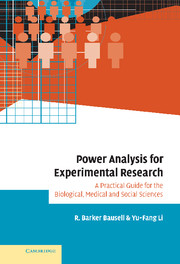 Power Analysis for Experimental Research
Power Analysis for Experimental Research Book contents
- Frontmatter
- Contents
- Introduction
- 1 The conceptual underpinnings of statistical power
- 2 Strategies for increasing statistical power
- 3 General guidelines for conducting a power analysis
- 4 The t-test for independent samples
- 5 The paired t-test
- 6 One-way between subjects analysis of variance
- 7 One-way between subjects analysis of covariance
- 8 One-way repeated measures analysis of variance
- 9 Interaction effects for factorial analysis of variance
- 10 Power analysis for more complex designs
- 11 Other power analytic issues and resources for addressing them
- Technical appendix
- Bibliography
- Index
6 - One-way between subjects analysis of variance
Published online by Cambridge University Press: 28 August 2009
- Frontmatter
- Contents
- Introduction
- 1 The conceptual underpinnings of statistical power
- 2 Strategies for increasing statistical power
- 3 General guidelines for conducting a power analysis
- 4 The t-test for independent samples
- 5 The paired t-test
- 6 One-way between subjects analysis of variance
- 7 One-way between subjects analysis of covariance
- 8 One-way repeated measures analysis of variance
- 9 Interaction effects for factorial analysis of variance
- 10 Power analysis for more complex designs
- 11 Other power analytic issues and resources for addressing them
- Technical appendix
- Bibliography
- Index
Summary
Purpose of the statistic
The one-way between subjects analysis of variance (ANOVA) is used to ascertain how likely the differences among three or more groups would be to occur by chance alone. It is a direct extension of the t-test for independent samples, which assesses only differences between two groups. The groups may be experimental conditions to which subjects have been randomly assigned (e.g., two experimental treatments vs. a control) or they may be defined by a naturally occurring phenomenon (e.g., a comparison of several different diagnoses with respect to the amount of chronic pain experienced). As with the independent samples t-test (other than the standard assumptions of the procedure itself), the only stipulations for its use are that the hypotheses being tested involve group means (which implies that the dependent variable is continuous in nature) and the groups are not made up of the same or matched subjects. Also, as with the t-test for independent samples, from a power analytic perspective, this procedure is not recommended if covariates, baseline values on the dependent variable, or blocking variables are available.
To review then, a one-way between subjects ANOVA is used when:
there is a single, independent variable which is defined as group membership in three or more groups,
the dependent variable is measured in such a way that it can be described by a mean (i.e., it is continuous in nature and not categorical),
the hypothesis being tested is expressed in terms of a mean difference, and
[…]
- Type
- Chapter
- Information
- Power Analysis for Experimental ResearchA Practical Guide for the Biological, Medical and Social Sciences, pp. 71 - 110Publisher: Cambridge University PressPrint publication year: 2002


